-
Car Reviews
- All reviews
- Midsize SUVs
- Small cars
- Utes
- Small SUVs
- Large SUVs
- Large cars
- Sports SUVs
- Sports cars
- Vans
Latest reviews
- Car News
-
Car Comparisons
Latest comparisons
- Chasing Deals
Electric six- and seven-seat SUV broadens its Korean maker’s model reach. But does the pricey electric flagship enrich or muddy Hyundai’s water?
Hyundai Australia wants to challenge Toyota for local sales domination. (Of course, which importer doesn’t?) And according to the importer’s CEO Don Romano, its new quasi-premium electric six- and seven-seat SUV that comfortably sails north of $120,000 in almost any configuration is a key lynchpin in its bold and relatively new strategy.
The Hyundai Ioniq 9 debuts as the most expensive Hyundai ever offered in Australia, trailing closely behind the launch of Inster, the brand’s newest ‘smallest’ (circa-$40K) model. Both, says the horse’s mouth, bring breadth and depth to the local line-up.
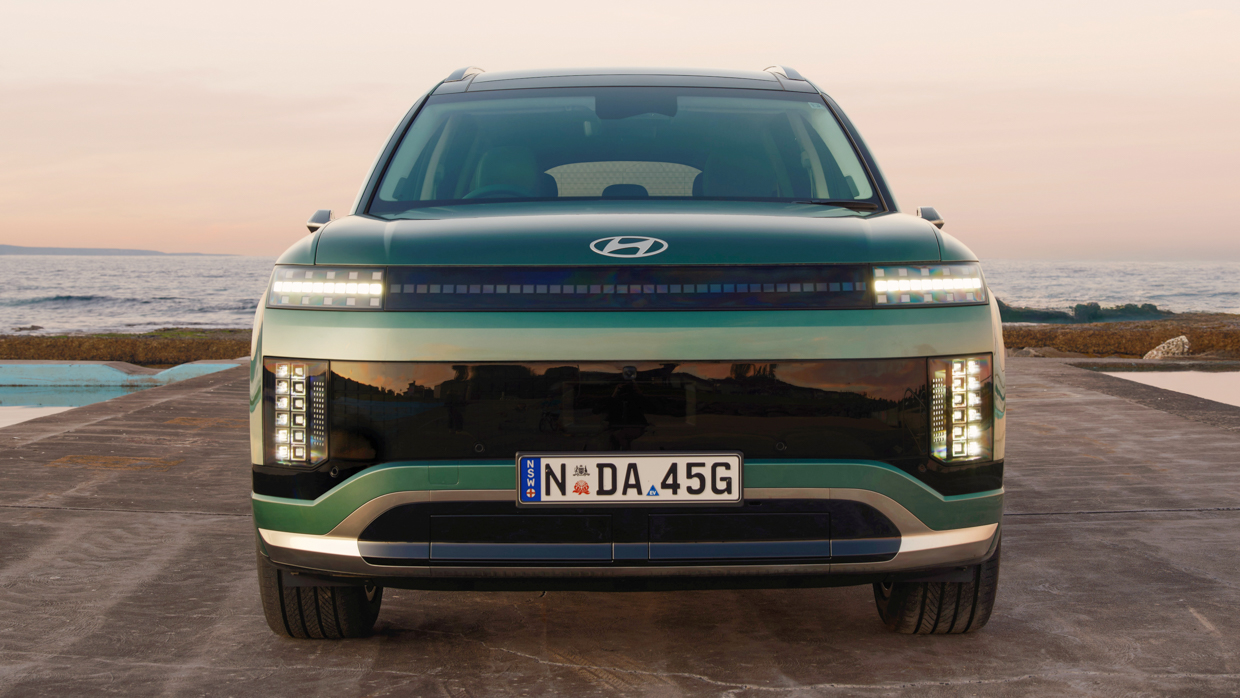
Big sellers? Doubtful. Especially the Ioniq 9. Some precedent is that the big electric figurehead from Hyundai’s cousin, the Kia EV9, hasn’t come within a postcode of its own sales aspirations in its 12 months since launch. And that’s despite the EV9’s critical acclaim and whatever brand recognition it’s brought to Kia locally.
What’s different with Ioniq 9? Design, clearly. Though the Hyundai’s bulbous, quasi-retro styling is no less polarising than the 1970’s manga-robot fetish of the EV9.
There’s range. Unlike EV9’s ambitious three-trim line-up, the Ioniq 9 lands Down Under in just a single Calligraphy guise. Hyundai has opted to go high-spec and pricey: $119,750 list for seven seats, two grand more for the six-pew ‘captains’ chairs’ format.
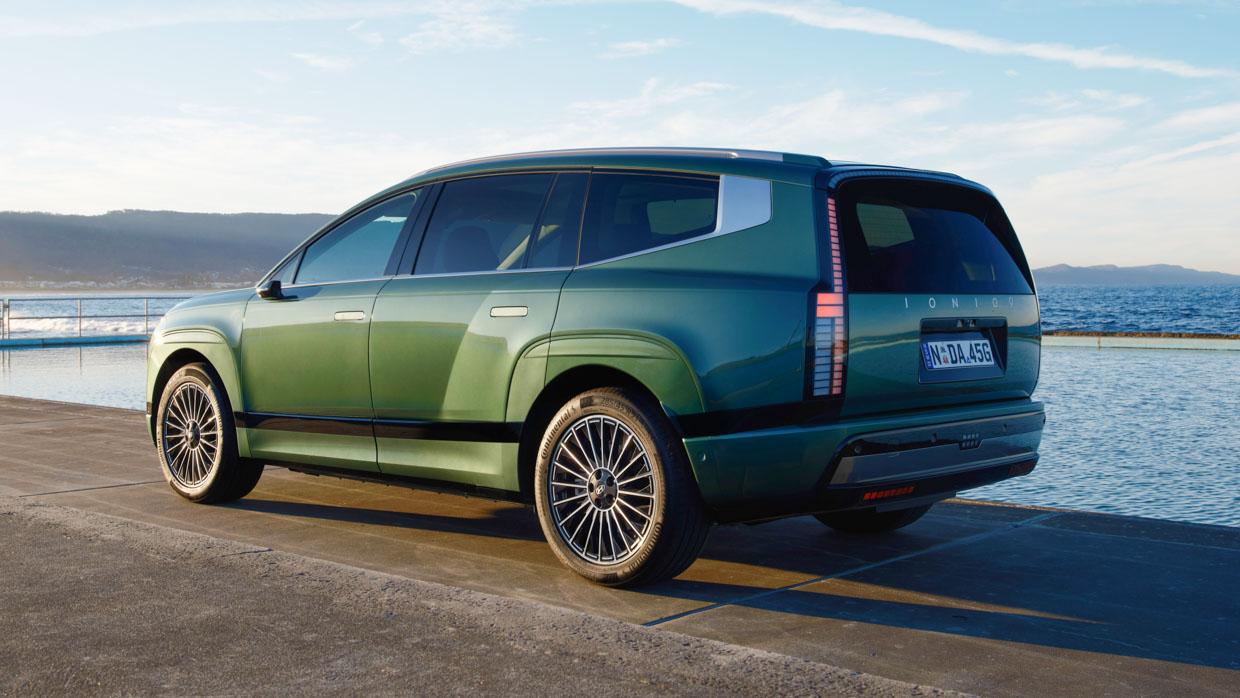
This begs many questions. Who buys a mega-buck Hyundai? Is this Hyundai pushing its brand upmarket? Does this cannibalise Genesis (and why wasn’t Ioniq 9 a Genesis from the get-go)?
And doesn’t Hyundai also offer many other three-row options — Santa Fe, Palisade, Staria — that are significantly lighter on the hip pocket?
All of these might be inconsequential if the Ioniq 9 Calligraphy is really good and really different, bringing unprecedented newness, trickiness and slickness to the Hyundai DNA (in ways that perhaps the Ioniq 5 did on debut a few years back).
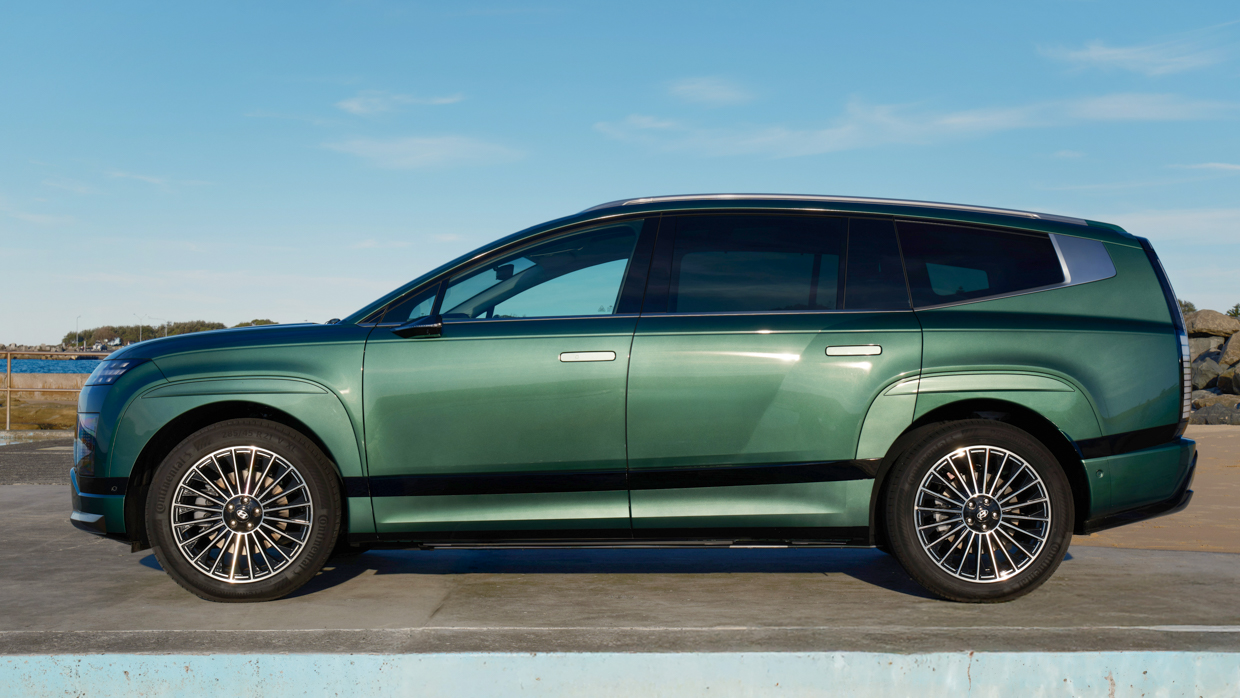
Styling? With no disrespect, the Ioniq 9 might appear, stylistically and in the flesh, like a Kia EV9 that crashed through the Ioniq 6 studio en route to the Santa Fe’s interior design department…before being rear ended by a Volvo.
It looks classy and modern yet strangely unremarkable. Those stolid diamond-cut 21-inch wheels, in your reviewer’s eyes, are not Hyundai’s most upmarket work.
Claim in and the interior is very nice, though it’s also very Ioniq-by-the-numbers and achingly reminiscent of Santa Fe in places. It’s a touch classier and richer in execution than the latter, and a peg below the sort of opulence Hyundai’s premium off-shoot Genesis mints in its own models, with presentation and panache pretty much where it ought to be.
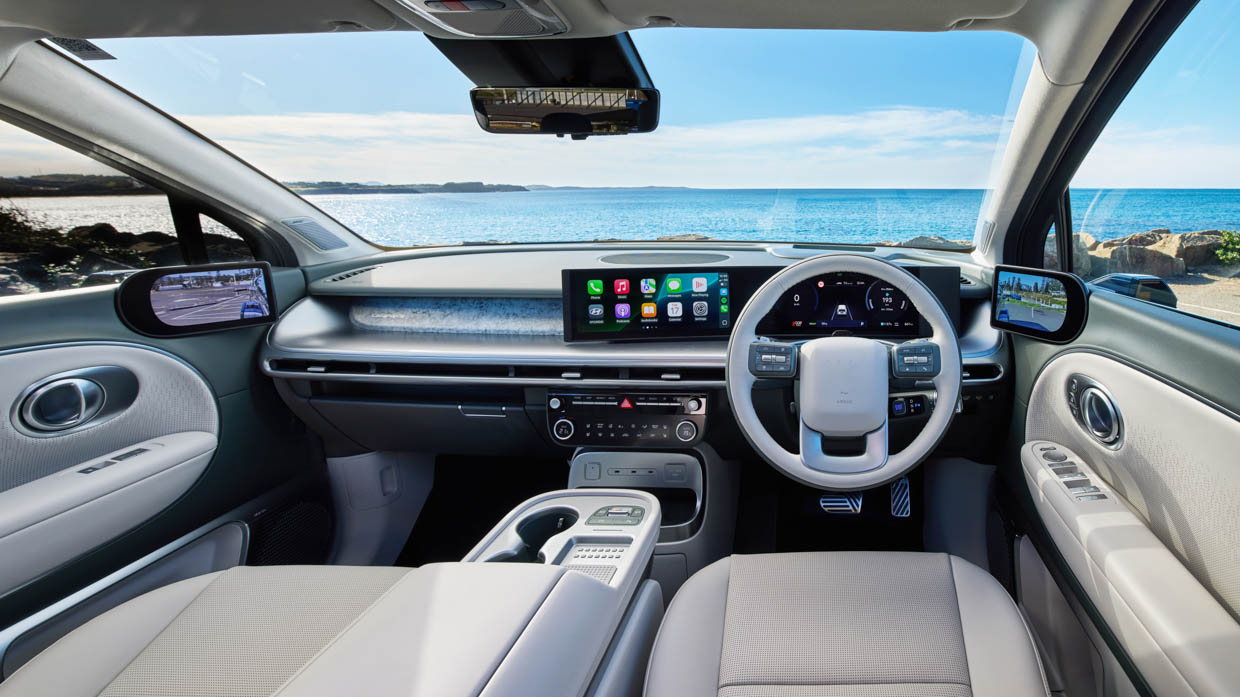
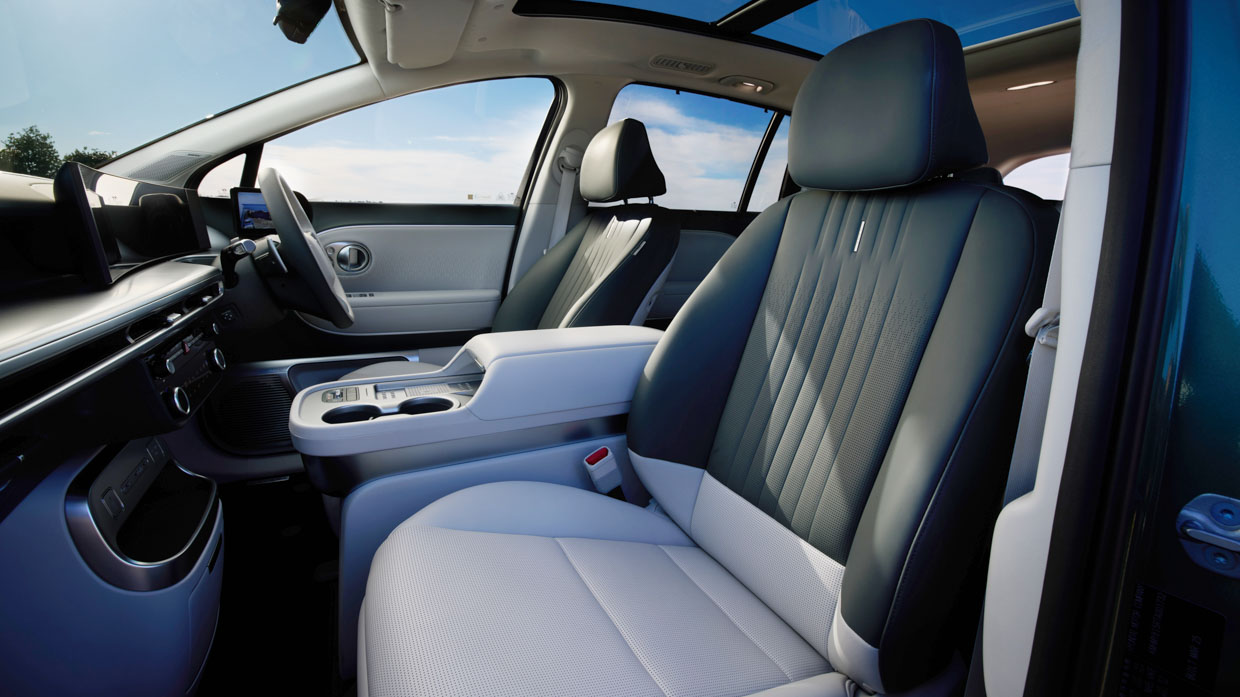
The problem is that, bar the questionable real aluminium dash inserts — adjacent to some very plasti-chrome looking and feeling dash fascia trim — the cabin of the $120K super-Hyundai is largely derivative of other, vastly more affordable models in the brands line-up. Minor details apart, there’s not a lot new, or at least not much that presents as much.
Still, it delivers the austere luxury as promised on the tin. The Nappa leather-appointed 16-way front seats — with driver massage functionality — fit the hefty bill, complimented with suede-like headlining and subtle frosted silver highlights — no garish carbon-fibre here. How everything blends in together is very neat and presentable.
All available in four different colour themes to match with any one of ten different exterior colours. Hyundai expects some buyers to order preferred combinations — delivery times, it promises, are just a few months — though we expect dealer stock might mix conservative hues.
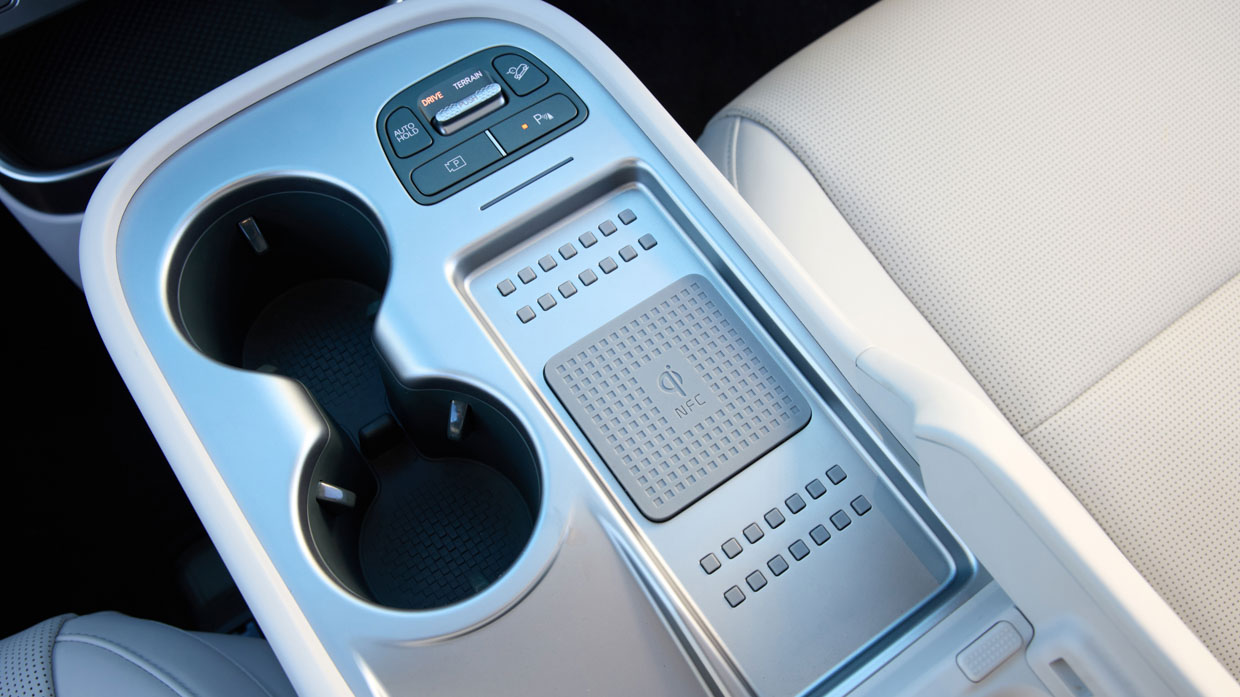
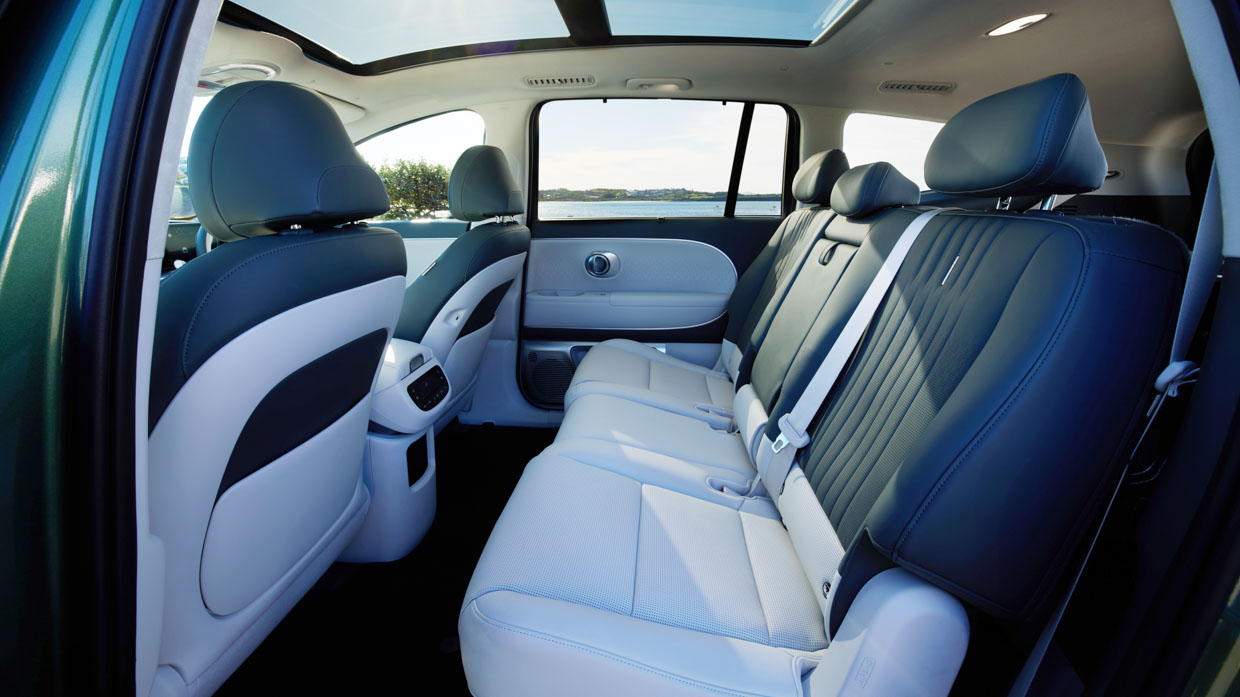
On that, an extra $750 sting for metallic paint at this price point is a bit of a rub, while it’s $1000 for matte paintwork (the silver matte looks particularly fetching in the metal). It’s an added $2000 for the six-seat option, while the tricky yet functionally woeful digital wing mirrors add another $3000.
Tick options and the Ioniq 9 blasts triumphantly north of $130K on road.
Dual 12.3-inch screens, dedicated HVAC button and dial control panel, column-mounted rotary ‘direction selector’ — all tried, true and familiar stuff seen in more affordable models. There’s ample if not overly generous storage abound and the six-seat version brings a nifty sliding centre console — with two-way lid — to the front row.
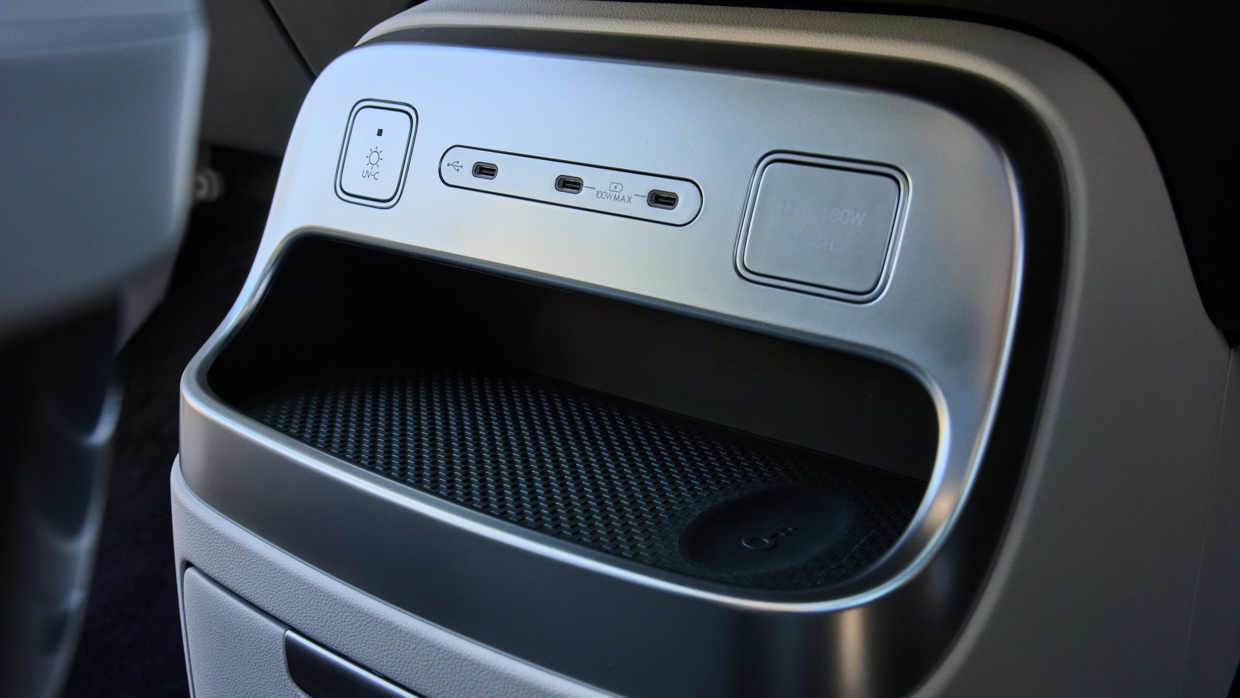
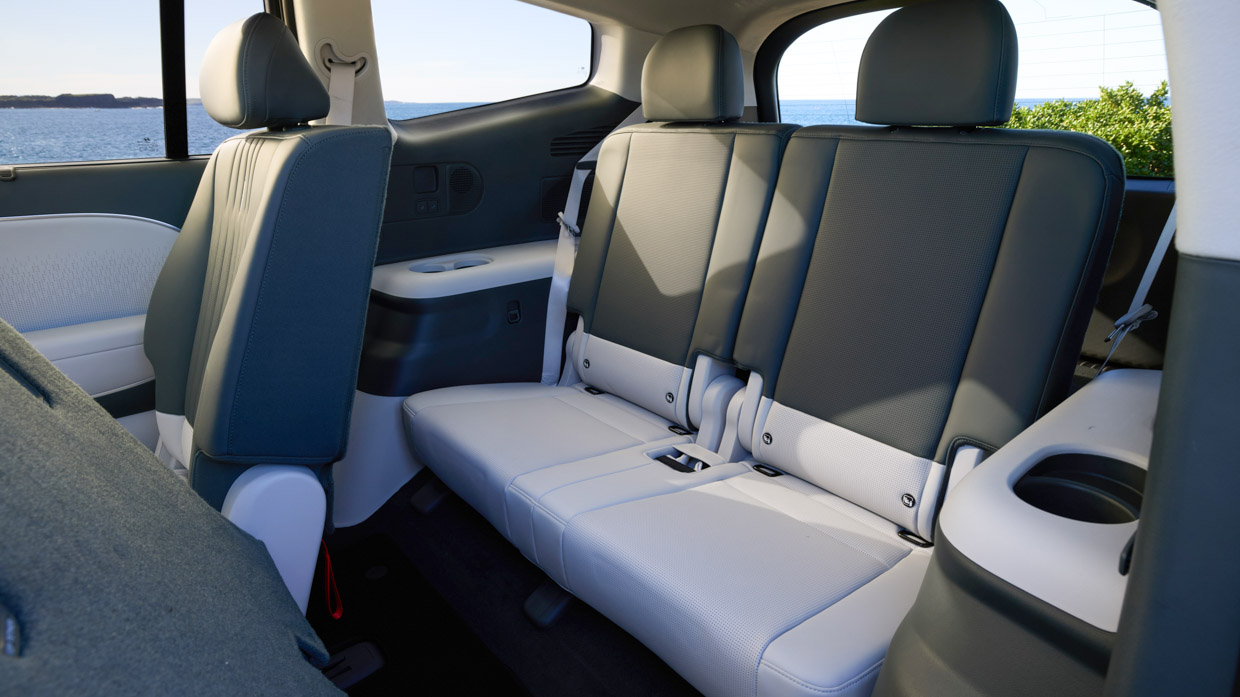
Some of the Ioniq 9 tricks, new connected features such as the Digital Key 2 where you can download a virtual entry and start-up key to your phone or up to 15 different devices, are neat. Others, like the UV-C phone sterilisation, seem more baked into the package in order to sprinkle added value to help justify the heady price tag.
Row two is very roomy and airy regardless of whether it fits a seven-seater’s bench or six-seater’s captain’s chairs. And with the electrically stowable third row the Ioniq 9 makes a helluva roomy and commodious five- (or four-) seater, as the 338-litre boot expands to a whopping 908 litres with an almost completely flat load space.
The flat rear floor, power reclining seat backs and USB-C outlet perched in the front-seat sides are all fetching luxury touches, though a strange miss is that the seven seat’s flip-side for best access to row three is actually driver’s side rather than (the safer) kerb side. Row three space is decent if certifiably kid-oriented for anything more than short trips.
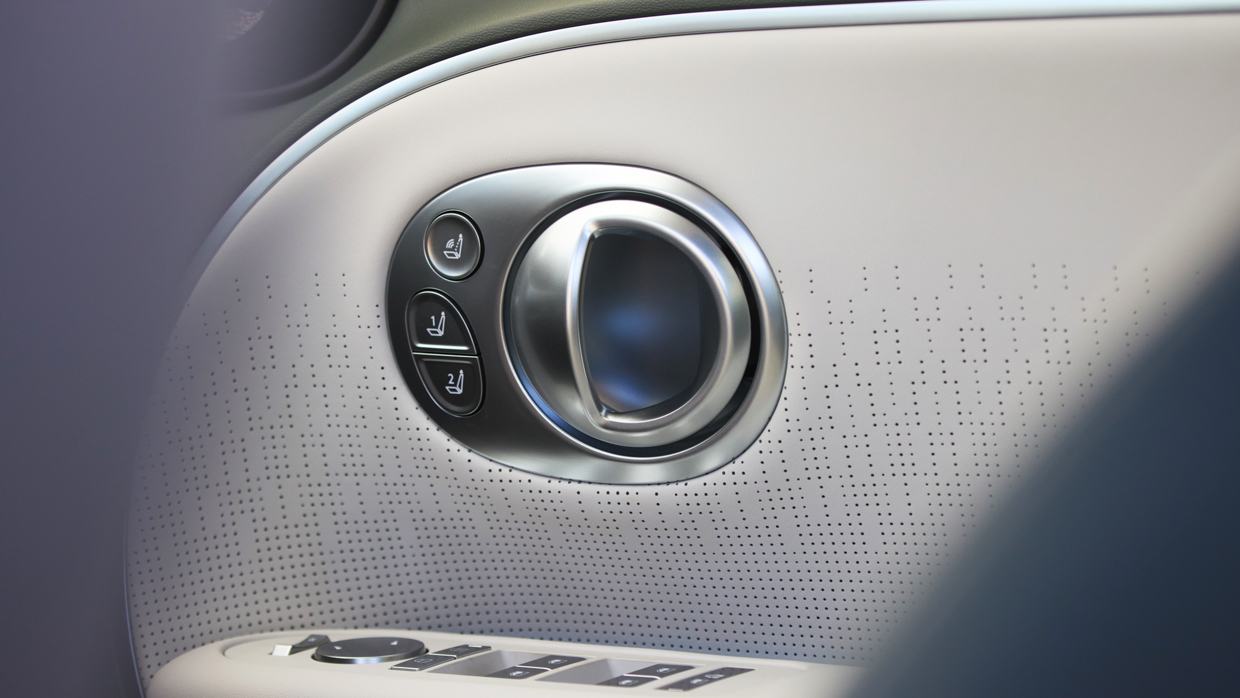
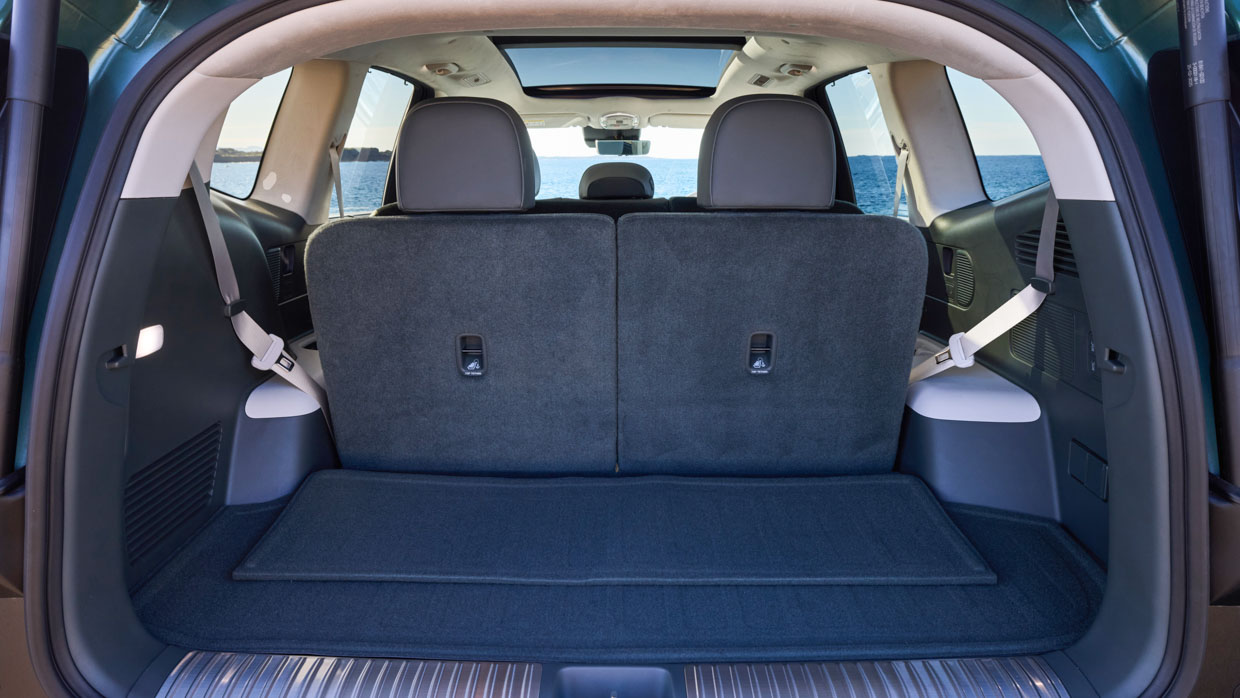
Some of the less-obvious luxuries seep into the on-road experience, such as the active road noise cancellation — a first for Hyundai. Subtler still are the sound absorbing pads in the tyres, and the three-layer sound deadening material in the wheel houses. These mostly hidden details are real Genesis-level luxury stuff.
The drive experience is…unremarkable. Or perhaps as remarkable as you could expect from a 2.75-tonne-plus five-metre behemoth that fast approaches its 3320kg GVM fully loaded with adults.
While unremarkable, the big electric is fully competent, as demonstrated on the road course selected for the Australian launch program starting from the guts of Sydney (at Hyundai HQ) and threaded north along the lesser travelled tourist routes up to the Hunter Valley winery region. And back along the Newcastle freeway.
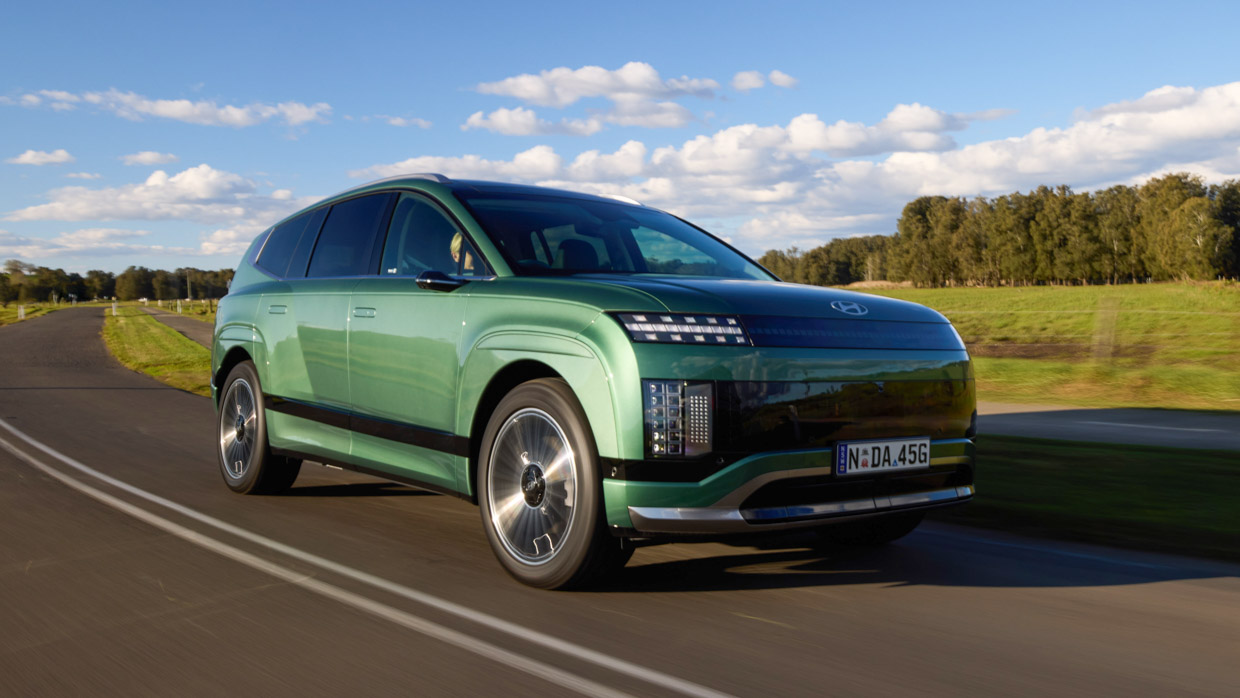
The Ioniq 9’s 800-volt E-GMP architecture fits a whopping 110.3kWh battery — Hyundai’s biggest yet — and a promise of 600 kilometres of WLTP driving range.
On test, while hardly punted for economic benefit and with around 130 kilometres of undulating highway driving, a combined consumption of 20.8kWh is pretty respectable for such a hefty EV package. Call it 530km as tested, driven without much sympathy.
It goes well, too. Two-up and with a moderate amount of luggage — not much change from three tonnes of mass — the Ioniq 9 is brisk off the mark and urgent when called to arms on a roll or when overtaking. All rounded and pliant and oh-so cooperative to the driver’s right foot inputs.

The powertrain outputs 157kW and 350Nm at each axle, both single speed, for a total of 314kW and 700Nm that proves both ample and utterly befitting for the big, luxury theme.
This is a rig that balances performance, drivability and outright range very nicely indeed, aided in part by Hyundai’s well-proven, simple-yet-effective paddleshift regen system.
At maximum, it’s effectively one-pedal response, at its lightest, there’s virtually no motor braking effect whatsoever. Choose your stepped setting for right foot comfort and conditions, or pluck the left paddle in faux-downshifts to curtail pace entering backroad corners. Neat!
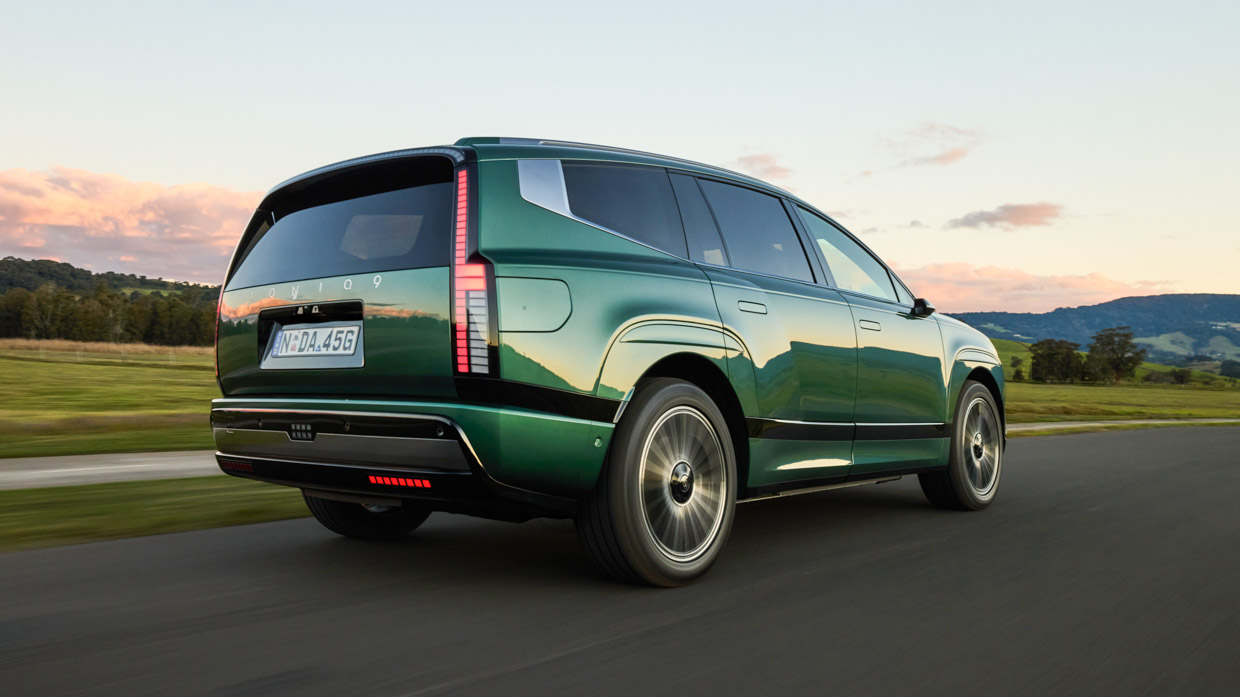
Where physics wins one over on the electric three-row SUV is in ride. Suspension is fully independent, steel sprung and with self levelling rear dampers for the multi-link rear. And its GVM with seats filled is around that of a one-tonne dual-cab ute teetering on the edge of its payload capacity.
What’s miraculous is that the electric SUV’s ride is about seven quantum leaps nicer and more compliant than any ute you could possibly name.
Still, the gross mass the suspension needs to support, combined with the huge 21-inch rolling stock, means that smaller, high-frequency bumps and sharp imperfections are felt more conspicuously than it might otherwise be with an air-suspended design.
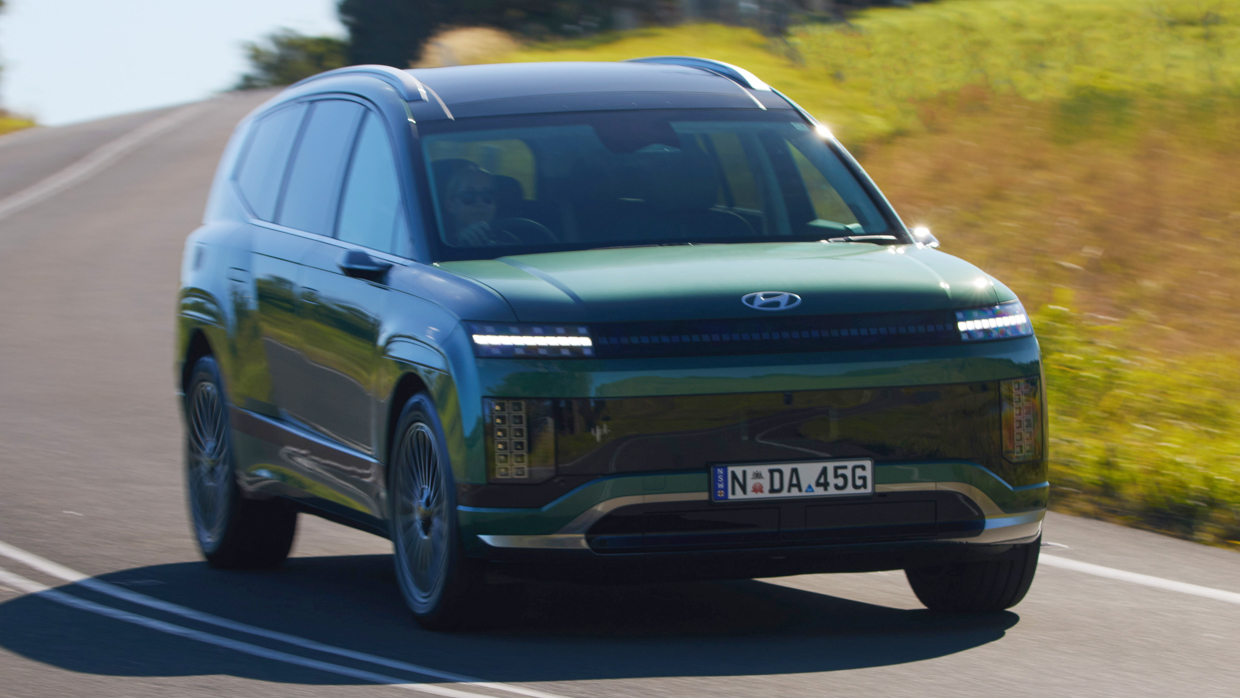
Similarly, the hefty weight lugged around blunts the dynamics. While not exactly ponderous, the three-row SUV demands a degree of circumspect guidance across sweeping backroads, given it easily drums up serious road speed, near silently and therefore somewhat deceptively.
But it is very comfy, near serene in its manner and properly un-fatiguing. This is Hyundai doing semi-premium luxury at the carmaker’s best, with a solidity and refinement that betters the well-regarded Santa Fe and is nigh on par with Genesis-like expectations.
And it’s primarily what the dizzying price tag is buying into.
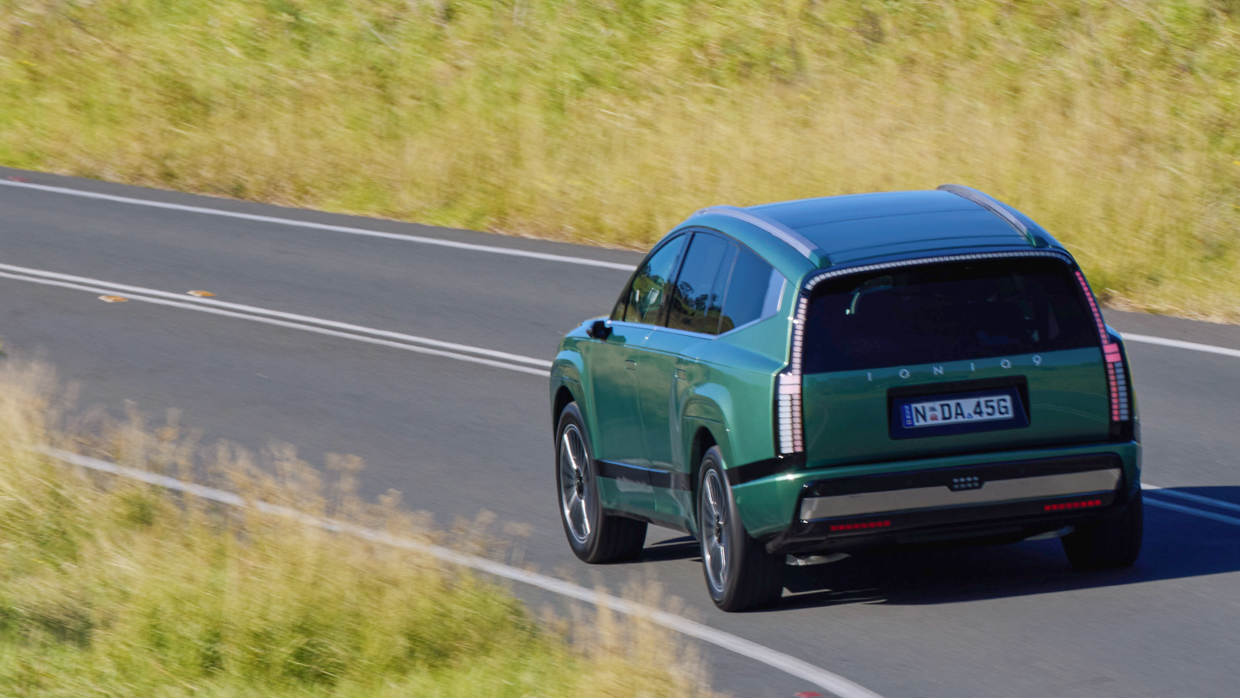
While the Ioniq 9 makes a neat big-dollar bookend to Hyundai’s range expansion strategy — “ICE, PHEVs and HEVs, from luxury to entry [grades],” HMCA says — with an incremental premium lift across the board, it’s both a good vehicle and tough sell on singular merit.
Hyundai Australia expects that buyers will largely be existing EV owners looking for a step up, rather than a perceptible ‘step backwards’ to internal combustion or hybridisation. That’s a pretty select group.
With EV adoption still dragging along in relative infancy in Australia, it’s tough to see many three-row family-hauler shoppers stumping up the considerable premium for Ioniq 9 over Hyundai’s — or others’ — six-, seven- and eight-seat ICE-based alternatives.
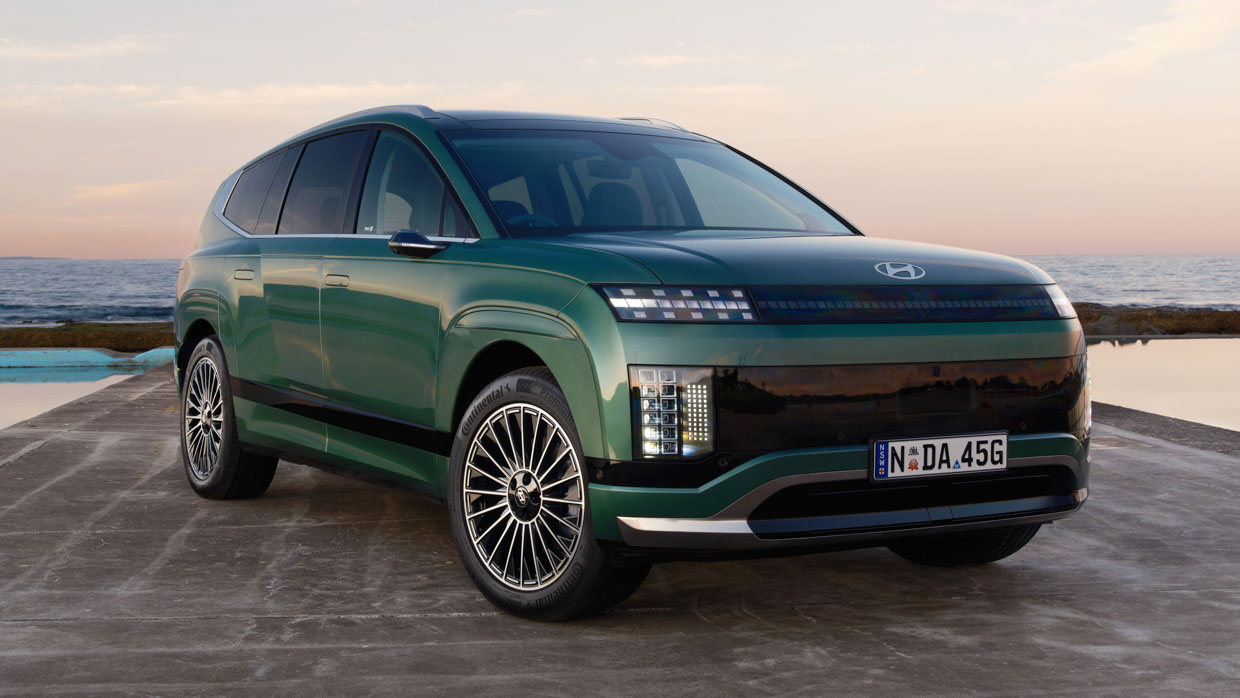
The upcoming (Q4 2025) hybrid Palisade is the clear and looming elephant in the showroom. It’s likely to be $40K, or even perhaps $50K, more affordable in like-for-like Calligraphy trim. It’s a handsome rig, too.
The Ioniq 9 Calligraphy feels primed, priced and positioned for a world where EV uptake might’ve been for more prolific. The right car at the wrong time, and in a less-than-ideal climate? Perhaps.
And perhaps an arguably shrewder move might have been to offer a more cut-priced specification sat more comfortably — and attractively — nearer the price of the top end of the line-ups of Palisade, Santa Fe, Staria and rivals’ logical competitors.
Key specs (as tested)
About Chasing cars
Chasing Cars reviews are 100% independent.
Because we are powered by Budget Direct Insurance, we don’t receive advertising or sales revenue from car manufacturers.
We’re truly independent – giving you Australia’s best car reviews.
The estimate provided does not take into account your personal circumstances but is intended to give a general indication of the cost of insurance, in order to obtain a complete quote, please visit www.budgetdirect.com.au. Estimate includes 15%^ online discount.
^Conditions Apply
Budget Direct Insurance arranged by Auto & General Services Pty Ltd ACN 003 617 909(AGS) AFSL 241 411, for and on behalf of the insurer, Auto & General Insurance Company Limited(ABN 42 111 586 353, AFSL 285 571).Because we don’t know your financial needs, we can’t advise you if this insurance will suit you. You should consider your needs and the Product Disclosure Statement before making a decision to buy insurance. Terms and conditions apply.
Indicative quote based on assumptions including postcode , 40 year old male with no offences, licence suspensions or claims in the last 5 years, a NCD Rating 1 and no younger drivers listed. White car, driven up to 10,000kms a year, unfinanced, with no modifications, factory options and/or non-standard accessories, private use only and garaged at night.
^Online Discounts Terms & Conditions
1. Discounts apply to the premium paid for a new Budget Direct Gold Comprehensive Car Insurance, Third Party Property Only or Third Party Property, Fire & Theft Insurance policy initiated online on or after 29 March 2017. Discounts do not apply to optional Roadside Assistance.
2. Discounts do not apply to any renewal offer of insurance.
3. Discounts only apply to the insurance portion of the premium. Discounts are applied before government charges, taxes, levies and fees, including instalment processing fees (as applicable). The full extent of discounts may therefore be impacted.
4. We reserve the right to change the offer without notice.